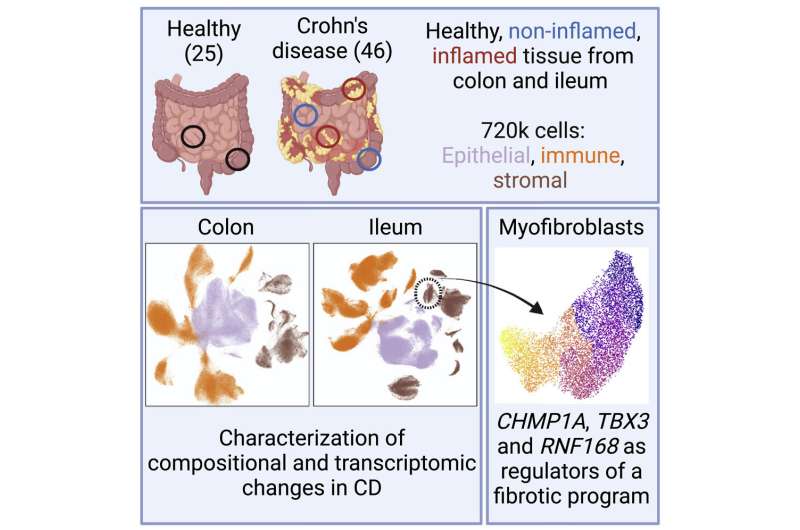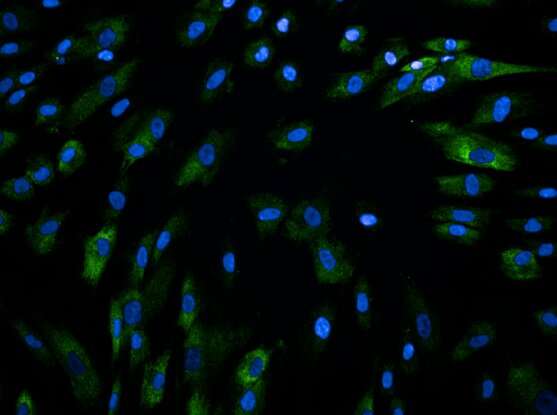This article has been reviewed according to Science X's editorial process and policies. Editors have highlighted the following attributes while ensuring the content's credibility:
fact-checked
peer-reviewed publication
trusted source
proofread
Single-cell analysis of Crohn's disease reveals a detailed picture of inflammation in the gut

Researchers at the Broad Institute of MIT and Harvard and Massachusetts General Hospital have constructed a high-resolution cellular map of Crohn's disease, a chronic condition in which a hyperactive immune system causes inflammation throughout the gut, leading to symptoms including abdominal pain, diarrhea, and weight loss. The disease is difficult to treat and often requires hospitalization.
The atlas is the largest study of single cells from Crohn's patients to date, and contains the gene expression profiles of more than 700,000 cells from 71 healthy individuals and patients in varying states of inflammation.
Published January 30 in Immunity, the findings offer a detailed cellular portrait into the biological processes underlying Crohn's that are unique to the small and large intestines. The data also reveal genes and pathways involved in complications of the disease, which could one day be targeted by new drugs. Moreover, the results could help researchers predict and ultimately prevent flares of symptoms, or understand why some patients respond to treatments and others don't.
"We're beginning to see that Crohn's disease is not one disease, and that it has many subtypes," said Ramnik Xavier, senior author of the study, core institute member and director of the Klarman Cell Observatory at the Broad. Xavier is also the Kurt J. Isselbacher Professor of Medicine at Harvard Medical School, director of the Center for Computational and Integrative Biology and core member in the Department of Molecular Biology at Massachusetts General Hospital, and co-director of the Center for Microbiome Informatics and Therapeutics at MIT. Lingjia Kong, a research scientist in Xavier's lab, was the study's first author.
"We really wanted to build a resource for the field," said Jacques Deguine, an author on the study and the associate director of the Immunology Program at the Broad. "There have been atlases across a range of diseases, but now our field has grown enough that we can start tackling these questions in complex diseases, involving different organs. This is moving the needle towards an individualized understanding of biology."
Inflammation insights
Previous genetic studies have identified more than 200 places in the genome linked to Crohn's. But Xavier's team knew that to fully understand the disease, they'd need a cellular map that captured its full complexity. They studied inflamed and non-inflamed cells from both segments of the gastrointestinal tract: the large intestine and the ileum, the last segment of the small intestine that is often affected in Crohn's disease.

The scientists used single-cell RNA sequencing to analyze gene activity in the individual gut cells. They found that immune cells and the stroma—the cells inside the gut that shape and support underlying connective tissue—changed in composition during disease. The lining of the intestines showed more changes in gene expression, with some changes unique to the large or small intestine. They also found that expression of genes previously linked to disease risk was distinct in each organ.
"I think this really lays the foundation for understanding why Crohn's disease inflammation manifests in one organ versus another, and how some treatments might influence different disease subtypes differently," Deguine said.
Toward personalized medicine
About 50% to 60% of Crohn's patients respond to drugs and some experience a relapse of symptoms. Xavier said this suggests that Crohn's is caused by a variety of biological mechanisms requiring treatments that are tailored to individual patients. He and Deguine added that many of their team's findings point towards possible targets for personalized treatments. For instance, they identified three genes involved in collagen production that likely contribute to scar tissue in the gut, making the intestines stiffer and less able to pass along food—a common complication of Crohn's.
To their surprise, the researchers discovered that Crohn's patients had certain gene expression signatures even when their tissues didn't look inflamed. This could indicate that there are detectable signs of disease even when the tissue appears to be healed on an endoscopy. Understanding the pathways that contribute to low-grade inflammation could help predict when symptoms will flare.
In the future, Xavier's team plans to extend their atlas by collecting samples from patients of a range of ancestries. Deguine also hopes to study patients before and after different treatments to track how their disease progresses.
"These projects are collaborative studies that include patients, clinicians, clinical coordinators, data generators, and computational biologists," said Xavier. "It's becoming clear that this is how biology needs to be done to have a real impact on human disease."
More information: Lingjia Kong et al, The landscape of immune dysregulation in Crohn's disease revealed through single-cell transcriptomic profiling in the ileum and colon, Immunity (2023). DOI: 10.1016/j.immuni.2023.01.002


















